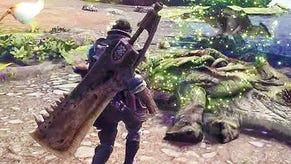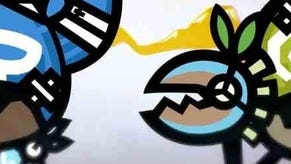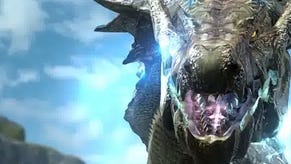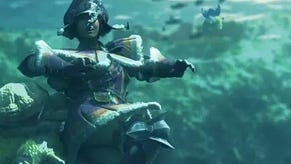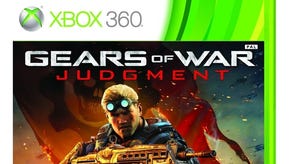Monster Hunter 3 Ultimate review
Big game.
Monster Hunter has never enjoyed much western success - and we're the losers. Of all Capcom's modern series, this co-operative action-RPG is one of the deepest, funniest and most rewarding. It lacks the nostalgia and immediacy of Street Fighter 4 or the big-budget production values of Resident Evil, but has something at its core that I find more fulfilling. Call it camaraderie, the rush of a team sport played well - with a sideline in snazzy uniforms.
Monster Hunter 3 Ultimate is available for both 3DS and Wii U; the two versions have the same content and you can play local co-op and share a save between them (eventually - see sidebar below). It's the definitive version of 2009's Monster Hunter Tri, the third entry in the series proper, each numbered Monster Hunter being a game that Capcom refines over the course of years and multiple entries. So the foundation is an old game, but one of exceptional durability and quality - though the first few hours do Ultimate no favours at all.
The opening quests are no good, really, too basic for experienced players and too bamboozling for new ones. They're designed to teach the basics slowly; from gathering to fishing and hunting small fry, it's a cascade of little factoids, menus and seemingly unrelated activities in which Monster Hunter's tightly-wound logic is far from immediately clear. This is a game in which you earn success, and in these early stages the earning is hard and the rewards are far from obvious.
The weapons are a perfect example. Each of Monster Hunter's weapons is effectively its own class, the use of which dictates a large part of your play style. Hammer users will be going straight for the head and dodging blows, while lance users will be under the monster and constantly poking it. Very little of this is explained in a simple way - and god help the neophyte who decides to pick the bagpipes.
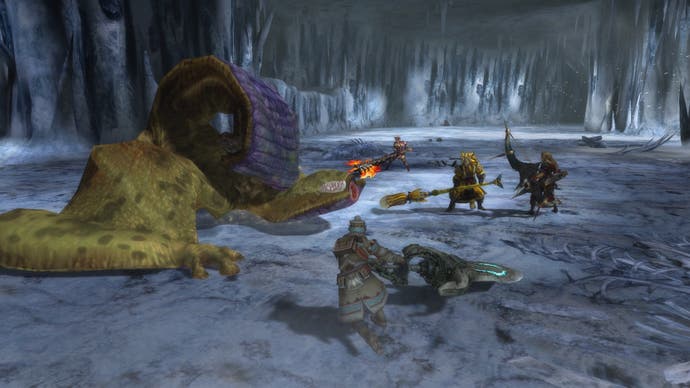
Yet from another angle, this is part of Monster Hunter's appeal, for players like me at least. You teach yourself, learning the move set quickly and then learning how to use it slowly. To give credit where it's due, Monster Hunter 3 Ultimate does scale up the monsters you face in a way that makes a lot of sense, from the Great Jaggis and Royal Ludroths of its early hunting grounds - powerful but predictable beasts - to the gigantic and deadly creatures that come later.
As you begin taking down bigger quarry, returning with the spoils and figuring out Monster Hunter's simple yet voluminous combining and crafting systems, your motivation becomes much clearer. Kill a few more of those fancy Qurepeco birds, for example, and you could make a pretty sweet pair of trousers. The single-player campaign's Moga Village evolves as you progress, and soon you realise it's perfectly equipped to automate the aspects of Monster Hunter that could be boring, like collecting ingredients. Essential stuff like honey can be outsourced to some cats. A hunting fleet can be upgraded and sent to take down monsters and bring back the loot. And then there's your house: who wouldn't want a fountain in the shape of a Lagiacrus?
Monster Hunter's two loops are the campaign and co-operative multiplayer, but it's best to think of the former as training for the latter. (One feature of Ultimate that deserves especial praise is its accommodation of determined solo players, incidentally, as all of the co-operative content is accessible on your tod - also useful for clearing up low-level quests and farming monsters.) In contrast to Moga Village, a lazy, Caribbean-style fishing port, co-op missions are accessed from the Tavern.
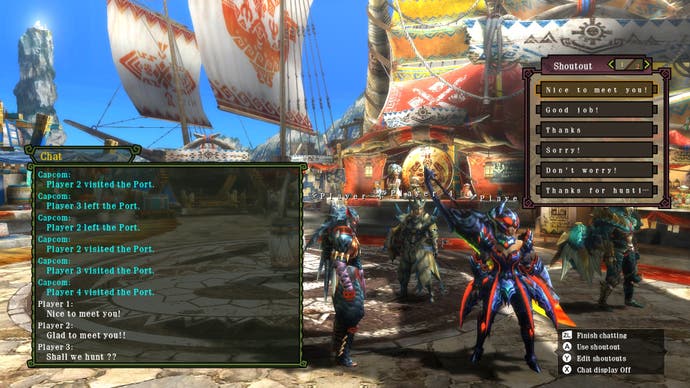
The tavern is an expression of a sociable theme that runs right through Monster Hunter - and it's part of what makes the big quests so special. When you're gathered with three other hunters and ready to go and take down something big, there's a kind of pre-hunt ritual. Usually some of the hunters will be prancing - unquestionably the finest of many gestures available - while some will be motionless in front of the item box or merchants as they tool up. And then everyone sits down for dinner. It's not even a mini-game, really; each hunter picks a combination of ingredients which will confer certain boosts during the quest and then hogs on it. No hunter goes out without a full belly, and it's hard not to smile and be swept along in the warm daftness of this ritual.
Out on the field, it's much more serious business. The multiplayer game sees you increase your Hunter Rank by completing quests, with each stage bringing a slew of new and more dangerous opportunities. The first two Hunter Ranks are perfectly pitched at players new to co-operative questing, setting up large and tough but less deadly monsters, like the Barroth, before turning the screw a little at rank two with quests like hunting a Rathian and a Rathalos. Once rank three is hit, however, the challenge spikes - and by this point, Monster Hunter has you. By now you'll have the know-how and capabilities to start crafting an ultimate weapon or armour set, and begin walking through the fire towards it. When you reach it, of course, there may well be another.
None of this would matter if the hunting itself wasn't special, but Monster Hunter 3 Ultimate is the very best. Taking on something big really feels like a fight. The first time you face a Barroth, its head-down charge and tail swings will batter you around like a rag doll. The fantastic, booming audio design has roars that make your hairs prickle, intimidating you in a primal way, while the screen blurs and jars to accentuate the effect.
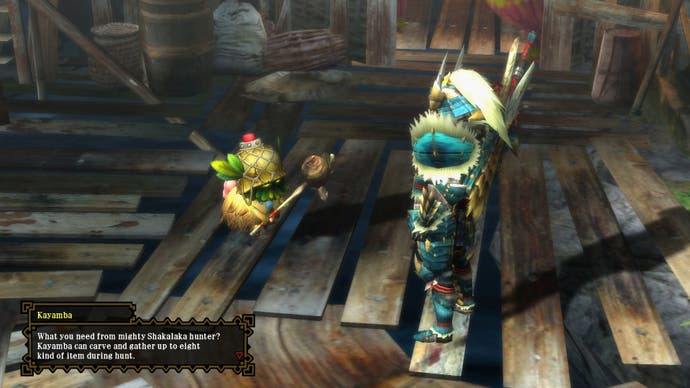
The screams give Monster Hunter's beasts an unusual level of personality in combination with one other touch: they get injured. As fights wear on, certain bits of a monster's body can be broken, sometimes clean off. Even if this doesn't happen, they'll eventually tire and weaken; after a certain point, these bosses just want to escape. They will fall over their own legs in panic as they try to run away, or limp towards open air and fly as far as possible, and if they get half a chance they'll take a nap or feast on something lower in the food chain. When Monster Hunter switches from the fight to the chase, it changes pace and also location, which means a different kind of fight - and as any hunter knows, a beast is at its most dangerous when cornered.
The finish is always a matter of taste. Inexperienced crews strike down the monster and then fall upon the carcass, hacking off the loot in another of Monster Hunter's little rituals. After a bit of practice, you'll start setting traps and bringing them in alive, something that needs careful judgement and timing, but the rewards are worth it. Either way, the end of an epic Monster Hunter quest (and from Hunter Rank 3 onwards, they pretty much all fit that description) feels like winning against the odds. It's a glow.
Monster Hunter's endgame, G-Rank, is why people go so mad over this particular series, and rightly so. The monsters become ever more dangerous, with new moves and more unpredictable behaviours, and truly mastering even one of the fights is a daunting task. You craft fabulous armour sets from a Diablos after killing it 10 times because, the next time some dudebro sees you in the tavern, he'll know you're the boss of Diablos.
A master-class in precision combat design matched to an intricate system that ties isolated fights together... a fantasy world of such original vision that it disarms and envelops you
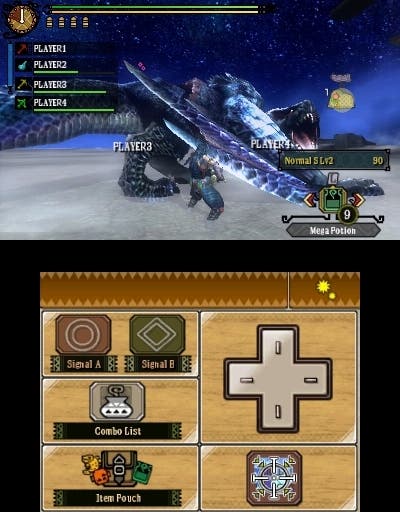
Monster Hunter 3 Ultimate's problems are mostly mere irritants, with two exceptions. The rather basic visual upgrade isn't a huge concern, because what's important about Monster Hunter - the fighting - looks incredible in high definition on Wii U. On 3DS, the 3D effect makes certain monsters look spectacular and goes some way towards alleviating the drop in detail. But many other elements, like the character models in Moga Village or the text on 3DS, are uncomfortably basic, while certain visual effects, such as the lighting in caves, are just awful.
You'll get over such infelicities. The major issue is the lack of online play for the 3DS version, which makes it a much tougher recommendation on its own (unless you have three friends in exactly the same spot) and a definite loser to the Wii U release. The second problem, common to both versions, is that during close-up fights with something massive the camera can sometimes go haywire. You can deal with this, mostly, but very occasionally you'll take a hit from it.
The core of Monster Hunter 3 Ultimate, however, is a shining light - a master-class in precision combat design matched to an intricate system that ties isolated fights together. Ultimate's world may be made up of little more than a few villages, a tavern and a handful of hunting grounds, but it has a rich texture to it that far more grandiose titles aim for and miss. It's a fantasy world of such original vision that it disarms and envelops you.
There are cats everywhere, countless dinners and silly dances, while grilling a Well-Done Steak triggers a woman's voice saying "sooo tasty" - and by the time you craft that Gigginox vampire outfit, none of this seems disparate. Everything is of a piece, whole and entire, as if the developers set out to make exactly this game and succeeded. That doesn't mean it's flawless. It only means that, sometimes, it feels like it.


